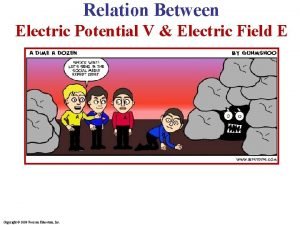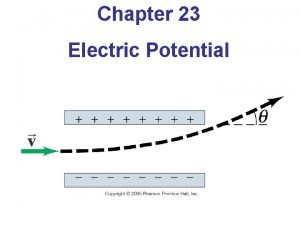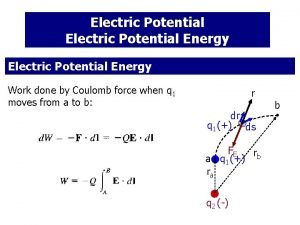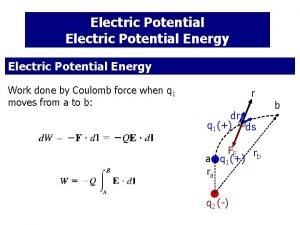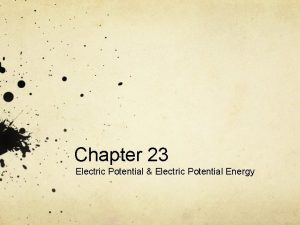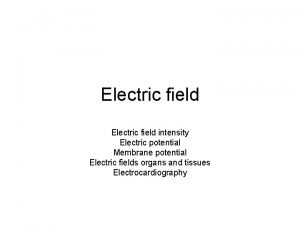Electric Potential and Energy Electric Potential energy Recall











- Slides: 11

Electric Potential and Energy

Electric Potential energy Recall that work is done to change an object’s energy type or energy value. In electrical circuits, batteries do work to give charges electric potential energy which they can use to do work on loads like lamps or resistors, etc. The movement of charge through an electric field (parallel to the field lines) means the field will do work to change the charge’s electric potential energy. When a charge moves perpendicular to the field lines NO work is done.

Electric Potential energy Work is the dot product of force and displacement. Thus: Ee = Fe●r = kq 1 q 2 ●r r 2 = kq 1 q 2 r The electric potential energy approaches zero as r approaches infinity. An electric potential energy between opposite charges is negative; this is not a direction. (Energy is a scalar).

Electric Potential Electric potential (or Voltage) is a measure of how much energy a charge carries with it. (A 12 V battery gives electrons 12 J of energy for every Coulomb of charge. 1 Coulomb is 6. 25 x 1018 electrons). 1 V = 1 J/C (A scalar) I V is the electric potential at a point in an electric field if 1 J of work is required to move 1 C of charge from infinity to that point. V = Ee q 2 V = kq 1 r

Electric Potential Note: Any formulae with k in it deals with point charges (individual charges of small radii) so these can NOT be used for problems with parallel plates as there are millions of charges on the plates. Potential difference is the change in electric potential energy of charge q moving from point A to B (like across the terminals of a battery might yield a PD = +12 V but across a resistor the PD might be = - 12 V). V = E/q

Electric Potential and Parallel Plates For parallel plates, an applied voltage means an electric field exists between the plates. The plates have the ability to do work on charges. The parallel plates have an electric field based on the accumulated effect of millions of charges on the plates: |E| = V/ d where d is the plate separation

Energy Conservation Problems Energy conservation can be applied such that electric charges accelerated by electric fields will undergo a change in kinetic energy. Examples: An electron is accelerated by 500. V. a) What is the kinetic energy gained by the electron in Joules and electron-Volts? Ee = Ek = q. V = 1. 60 x 10 -19 C (500 V) = 8. 00 x 10 -17 J/(1. 60 x 10 -19 J/e. V) = 500. e. V

Energy Conservation Problems b) Find the speed of the electron at the end of the acceleration period. Ee = E k 8. 00 x 10 -17 J = (0. 5)mv 2 = (0. 5)(9. 11 x 10 -31 kg)v 2 v = 1. 33 x 107 m/s Example 2) An electron is between two parallel plates with the upper plate positive. An applied voltage of 400. V is attached to the plates and the plates are 3. 00 cm apart. Find the acceleration of the electron.

Potential at a point Example 3) 3. 0 cm 4. 0 cm 20. 0 n. C Find -18. 0 n. C J Ee between the two charges and VT at point J. Ee = kq 1 q 2 r = 8. 99 x 109 Nm 2/C 2(20. 0 x 10 -9 C)(-18. 0 x 10 -9 C) (0. 040 m) = - 8. 1 x 10 -5 J

Potential at a point Example 3) 3. 0 cm 4. 0 cm 20. 0 n. C -18. 0 n. C J V = kq and VT = V 1 + V 2 r = 8. 99 x 109 Nm 2/C 2{(20. 0 x 10 -9 C) +(-18. 0 x 10 -9 C)} {(0. 04 + 0. 03)m = 2. 569 x 103 V + (- 5394) V = - 2. 8 x 103 V 0. 03 m}

Example 4 Find the electric potential energy between a magnesium nucleus and an alpha particle separated by 12. 0 nm. [4. 60 x 10 -19 J]
 Electrical potential energy
Electrical potential energy Electric potential unit
Electric potential unit V = pe/q
V = pe/q Define electric potential and potential difference.
Define electric potential and potential difference. Electric potential
Electric potential Electric potential unit
Electric potential unit Electric field and energy
Electric field and energy Electric potential electric field
Electric potential electric field Potential energy and electric field relationship
Potential energy and electric field relationship Relation between potential energy and electric field
Relation between potential energy and electric field Work done per unit coulomb
Work done per unit coulomb Potential energy of an electric field
Potential energy of an electric field








